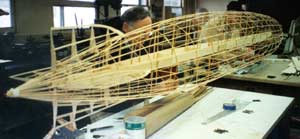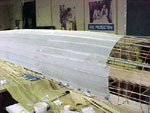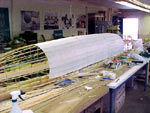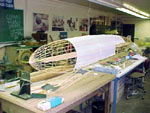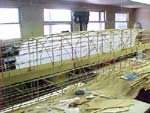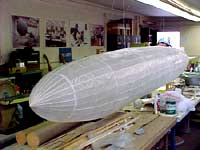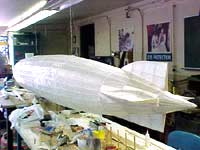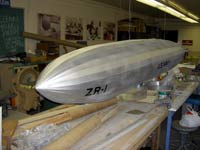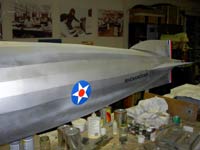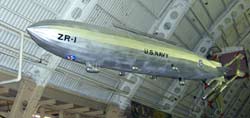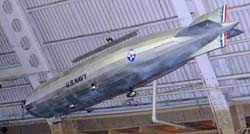Home
The Airship Shenandoah
Synopsis
From the beginning of time man looked at the birds and dreamed of flying. Flying meant freedom from danger, freedom to cover large distances without obstacles and predators. Thousand of years would pass before man would finally make the leap. In the sixteenth century Leonardo Da Vince postulated the design of a flying machine. Lacking a power source it never got off the ground. Powered flight by a heavier than air craft was not achieved until 1903 by the Wright Brothers.
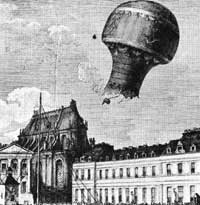 |
| Montgolfier's
Hot Air Balloon over Paris |
It took a paper maker by the name of Montgolfier in 1782 to launch man into the air in France. Montoglfier noticed that smoke from a fire built under a paper bag cause it to rise in the air. Like most people at the time he did not understand the concept of hot air expanding and thus weighing less by volume then the surrounding air. Scientist of the time had manufactured hydrogen but could not figure out how to contain it. Montoglfier theorized that the fire created a gas that was lighter than air.
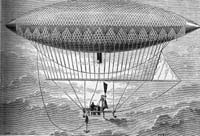 |
| Steam
Powered Flight |
Up until this time the direction of flight was dependent on the direction of the wind. Many attempts were made to provide a means of propulsion. All were people driven. One concept used oars, another used a screw turned by a team of men. All were doomed to failure. About the best any of the approaches could achieve was about 3 miles per hour and only for short periods of time. It wasn't until 1852 that Henri Giffard made the first successful man carrying powered flight using a 3 hp steam engine. Unfortunately the horsepower to weight ratio was not very good because of the weight of the water required for the boiler. The propulsion problem was finally solved with the invention, in 1860, of the gas engine.
The shape of the balloons were also changing. They became elongated shapes with boat like gondolas. These tended to collapse in the center as the gas was released. To solve this problem a beam was suspended under the balloon to which the gondola was attached. The ridged airship was born.
In 1886 the simultaneous invention, of a light weight material, called "aluminum" in both the United States and France allowed Count Ferdnand Von Zepplin to build his first dirigible the LZ1 in 1900. The hull was 420 ft long and 38 ft in diameter using 400,000 cubic ft of hydrogen. Unfortunately, the two 15 hp Daimler Marine engines that powered the LZ1 were not sufficient to drive the dirigible in a breeze.
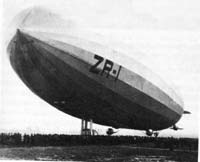 |
| Shenandoah
at Lakehurst |
Zeppelin continued to develop the dirigible funded by the German Military. As a result, at the start of World War I, Germany was the only country that had the capability for long range bombing and reconnaissance. One hundred and six airships were built during the war. In the beginning they had the potential of air superiority as the airplane was unreliable and could not sustain the altitudes or the flight times of a dirigible. As airplanes improved larger dirigibles were designed to be able to fly higher. One of the last was the L70, with 2,195,800 cubic feet of gas, could reach an altitude of 23,000 ft with a maximum speed of 81 mph. She was 693 ft 11 inches long Aircraft technology over took the dirigible and by the end of the war it was discredited as a combat weapon even in Germany.
What is of interest is the perception each side of the conflict had as to the value of the airship. In Germany the Navy high command thought that it was a very effective weapon for long range bombing of strategic targets in England. Airship commanders would report back that they had destroyed their intended targets of shipyards, factories and military installations. In fact their navigation and weather was so bad that they were generally off target by as much as 60 miles. What they were bombing was cow fields, villages and water. The net results were that they destroyed private property and killed close to 2000 citizens by wars end. The English, in defense were forced to deploy antiaircraft guns and aircraft to try to destroy the dirigibles. The English could never understand why the Germans put so much resources into airships just to bomb cow fields.
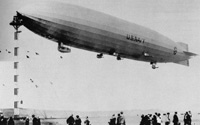 |
| Shenandoah
on Goodwill Tour |
Even when the Germans realized what was happening they still felt the airships were effective because they forced the English to deploy large amounts of resources to protect the cities that would have been sent to the front in Europe.
Besides long range strategic bombing, the airship’s intended use was used for reconnaissance. The German Navy staff knew that the English Navy was superior and that the only way they could overcome this was to be able to know where the English were so that they could focus their smaller forces against the English. Unfortunately for the Germans, they were never able to take full advantage of this capability because of weather or mechanical problems with the airships. On the other hand the English thought that the airship was effective because just before some major battles they detected the German airships in the area. What they, the English, did not know was that the airships never saw the fleet or they, could not contact the surface fleet to give the location of the English.
The English tried to develop their own airship industry. The major reason was that Germany was a rival and they felt that they had to understand the technology. The English were never successful in developing their own until they started to copy the captured German Zeppelin that had crashed. They were never a factor in the war.
With all this background why did the United States want to develop an airship industry?
 |
| Shenandoah
Supporting the Fleet |
In the Washington treaty of 1922 the United States, England and Japan agreed to limit the strength of their navies to a ratio of 5 US, 5 English to 3 Japan. The Navy felt that this would put them at a disadvantage in protecting the Philippine Islands as the Japanese fleet could operate from nearby bases in the Marshalls and the Carolines where the US fleet would have to cover the whole Pacific Ocean. The only way that they could counter this force was to have long range reconnaissance capability to focus their limited resources.
Congress authorized the purchase of three airships. The Shenandoah, to be built in the United States with the objective of establishing an airship capability in America, was authorized in 1919. The R-38, an English airship, also authorized in 1919. The Los Angeles built in Germany by the Zeppelin Company authorized in 1922. The R-38 was never delivered as it crashed in a training flight in England.
An alliance was formed between Goodyear industries and Zeppelin to build the Shenandoah. The Shenandoah made her first flight on September 4, 1923 and was the first ridged airship that was inflated with helium.
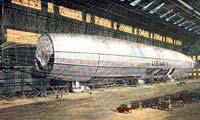 |
| Under
Construction |
The Shenandoah (ZR-1), was assembled inside Hangar No. 1 at NAS Lakehurst. The parts were fabricated at the naval aircraft factory (NAF) at Philadelphia and were transported to Lakehurst by truck and by rail. The first ring or frame, from mid ship, reached the base in late April 1922. The hull of the rigid airship was composed of alternately spaced main and intermediate rings or frames connected by longitudinal girders. Twenty gas cells provided the lifting element of the aircraft. The outer cover was made of high-grade cotton fabric, the cover panels were laced tightly into place over the entire hull and given several coats of "dope" which shrunk the material tight against the framework.
The final coat was mixed with aluminum powder to provide a smooth, weather-resistant skin which also reflected the sun's heat away from the lifting gas.
The five Packard 1A-1551 engines with a total horsepower of 1500 hp were suspended outside and away from the hull in separate pods. The aft power car and the control car were equipped with handling rails for ground crews, which allowed the aircraft to rest on the ground at these two points. The forward car was suspended from the hull by struts and cables.
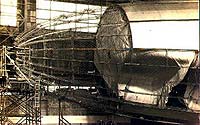 |
| Rebuilding
the Nose after Storm Damage |
ZR-1 had been designed for hydrogen, not helium. But the R-38 tragedy, in August 1921, generated concern about the use of hydrogen, and the Bureau of Aeronautics had recommended that the new ship be inflated instead with inert helium.
When completed the airship displaced 2,289,861 cu ft with an overall length of 680 ft 2 in and a diameter of 78 ft 9 in It had a total gross weight of 129,000 pounds that included a payload lift of 48,774 pounds. With a maximum speed of 51 kts. it had a range of 2,250 miles and 50 hours endurance. At cruising speed of 41 kts It had a range of 3,980 miles and an endurance of 54 hours. The nominal flight crew was 40.
Before it was destroyed in bad weather on September 3, 1925, it had logged 59 flights with a total time of 740 hours. It performed various missions including working with the fleet, cross country and good will flights.
The USS Shenandoah flew over the Los Angeles area in October 1924 as part of a cross country tour. It started in Lakehurst NJ and made a stop at Fort Worth TX before flying over the Rockies and mooring in San Diego. From there it flew up the coast to Tacoma Washington where it stopped to refuel before returning to Lakehurst back along the same route.
As the first airship it became the guinea pig for working out the many problems of operating with the fleet as well as training the crews.
The Shenandoah was scheduled for a goodwill tour of the mid west starting on September 1, 1925. Storms were usual during this time of the year in the mid west, but pressure was put on by the Navy Department to go ahead with the flight. The flight plan called for the airship to go from its home in Lakehurst, fly over Lafayette Indiana landing in Scott Field Springfield Illinois on September 3rd logging in 941 miles. The second leg was to fly over St Louis, Kansas City, Des Moines Minneapolis, Milwaukee, Kalamazoo, finally landing in Detroit on September 6th logging 1330 miles. The final leg, 671 miles took it over Flint, Bay City, Owosso and Lansing Michigan before returning home to Lakehurst. The total flight plan 2959 miles.
 |
| The
End |
At 4:20 am on September 3rd as the Shenandoah was over Cambridge, Ohio the airship started to experience an uncontrolled rise of 200 ft per minute. Despite corrective action to control the accent it continued to rise for 7 minutes achieving rates of 360 feet per minute. Later calculations showed that the Shenandoah was caught in an up draft of 1000 ft per minute. In that time she has gone from her cruising altitude of 1700 feet to 3600 feet. For the next six minutes the crew thought that they had the ship under control when the air became turbulent with the ship pitching and rolling. Again it began to rise at a rate of 225 feet per minute achieving rates of up to 1000 feet per minute. This continued for 11 minutes with the ship reaching an altitude of 6060 feet.
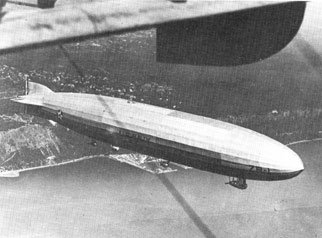 |
| Shenandoah |
During this period it was calculated that the updraft achieved rates of 2000 feet per minute. At this time she started to fall at a rate of 1500 feet per minute. This descent was arrested at 3000 feet when the ship was again hit with another up draft estimated at 4800 feet per minute. At 4:51 am she broke up. The crew fought to try to stabilize the airship throughout the ordeal, but the Shenandoah was never designed to withstand the rate of changes encountered. Twenty nine crewmen survived the crash.
Shenandoah Model Restoration
The twelve foot flying scale model of the Shenandoah was donated to the Western Museum of Flight by Tony Avak in 1987. To minimize the weight, the structure was made of 1/16 inch balsa wood and covered with tissue paper. The rings were made by forming two 1/16 by 1/16 inch strips of balsa wood in a circle and laminating them together. To keep the weight down, neither the structure or the tissue paper were doped. The engine pods and the gondola were hollow papier-mâché. The hull was filled with two helium bags when flown. For the full story click here.
Time and a Museum roof leak took its toll on the model. The paper disintegrated and the structure de-laminated, sagged and twisted. It was like a wet noodle. As this is an on going project, the status of the restoration story will be updated as progress is made.
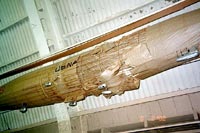 |
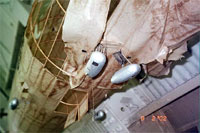 |
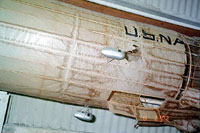 |
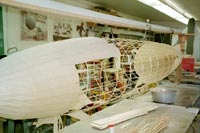 |
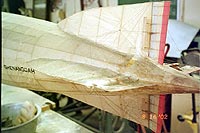 |
 |
Moved
to the Shop |
Damaged
Tail |
Starting
the Restoration |
 |
 |
 |
Rebuilding
the Tail |
Installing
the Tail Assembly |
Main
Spar Installed |
The
Completed Structure |
Doping
The Structure |

Work was also started in restoring the engine
compartments and the passenger gondola.
The covering of the Shenandoah nears completion.
|
||||
After
the airship was covered, it was sprayed with water to shrink the
covering. |
|
Final
paint and decals. |
|
 |
 |
 |
|
#1
Engine |
Control
Car |
#4 & 5 Engines |
#3
Engine |
The Airship Shenandoah |
|
Presently on display at the Western Museum of Flight at the Torrance Airport. |
|
| Return to Top | |

